People turn to various sources to stay informed about current events. From long-standing platforms like television and newspapers to digital channels such as websites and social media, the ways we get our news are more varied than ever. And not all channels have the same level of trust. To better understand where people obtained their news and which sources of news they trusted most, we asked a series of questions on this topic in our most recent wave of research. Let’s dive into what we uncovered.
Sources of News
Overall
Television news remains the most commonly used source, with 59% of respondents indicating they get their news from it. Online news websites follow closely behind at 50%, while social media platforms are used by 46%. Less frequently cited were friends or family (29%), podcasts (18%), and print newspapers (18%).
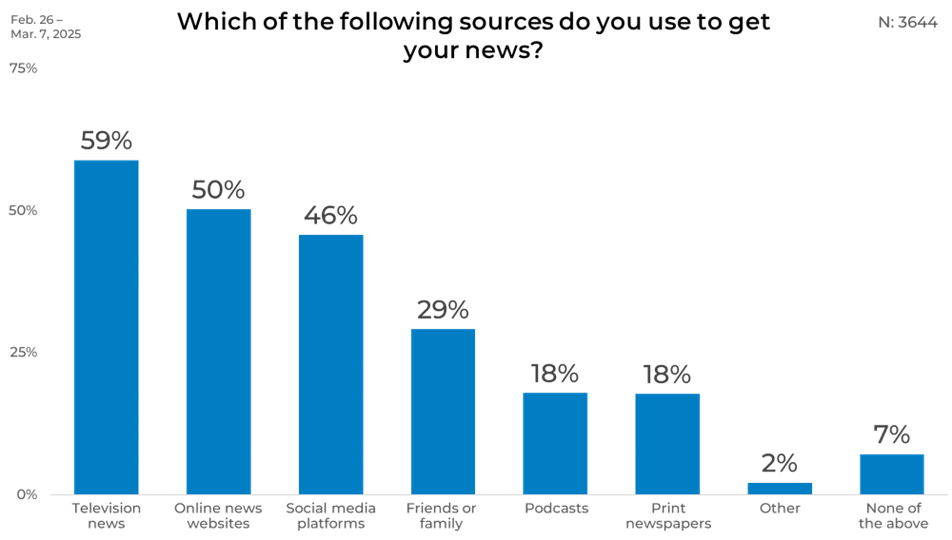
Gender
There are some slight differences by gender around the sources people use to get their news. Men are slightly more likely than women to consume online news (54% vs. 47%) and listen to podcasts (21% vs. 15%), showing a stronger preference for digital formats. Women, on the other hand, are slightly more likely to hear news through friends or family, indicating a more interpersonal route of information sharing. Television remains the top source for both, reinforcing its broad appeal regardless of gender.
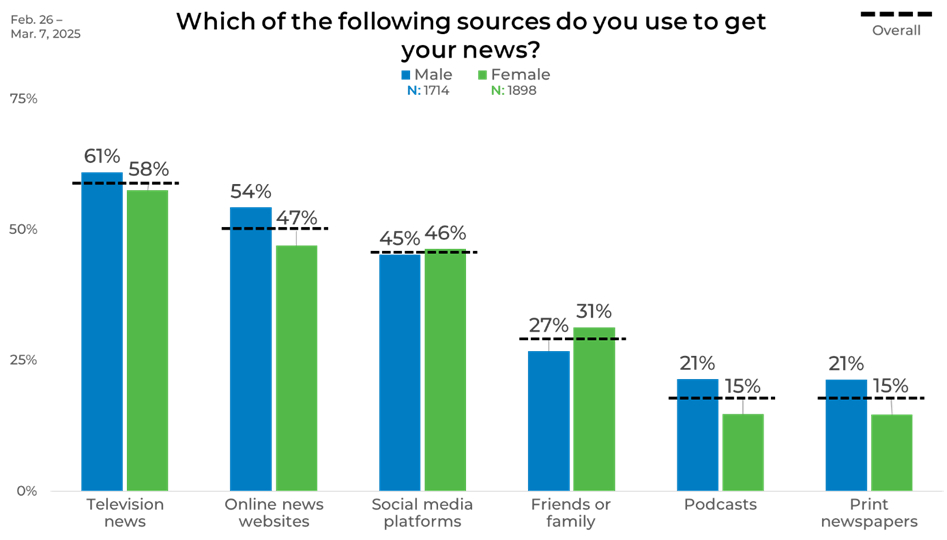
Age
There is a distinct generational trend in the way people obtain their news. Television dominates among older adults, with 82% of those 65 and older relying on it, while only 35% of 18-to-24-year-olds do the same. Social media follows an inverse pattern, being the top news source for 62% of the youngest age group but used by only 21% of seniors. Online news usage peaks among middle-aged adults, showing its role as a bridge between traditional and digital platforms.
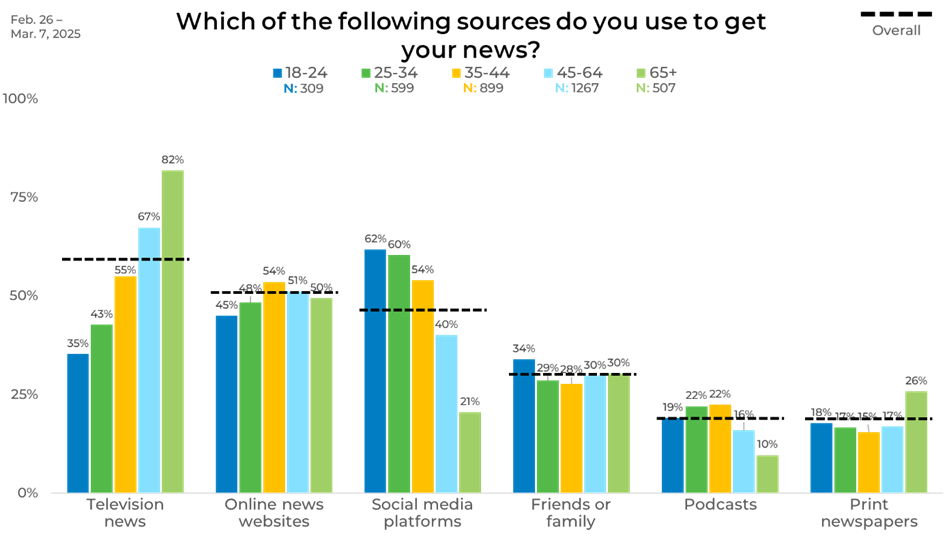
Income
There was an overarching trend regarding news sources and income – the higher the income, the more likely the source was used to obtain news. We observed this trend in nearly all sources. Additionally, lower-income respondents had the lowest levels of using any of the sources for their news, with no source receiving more than 45%.
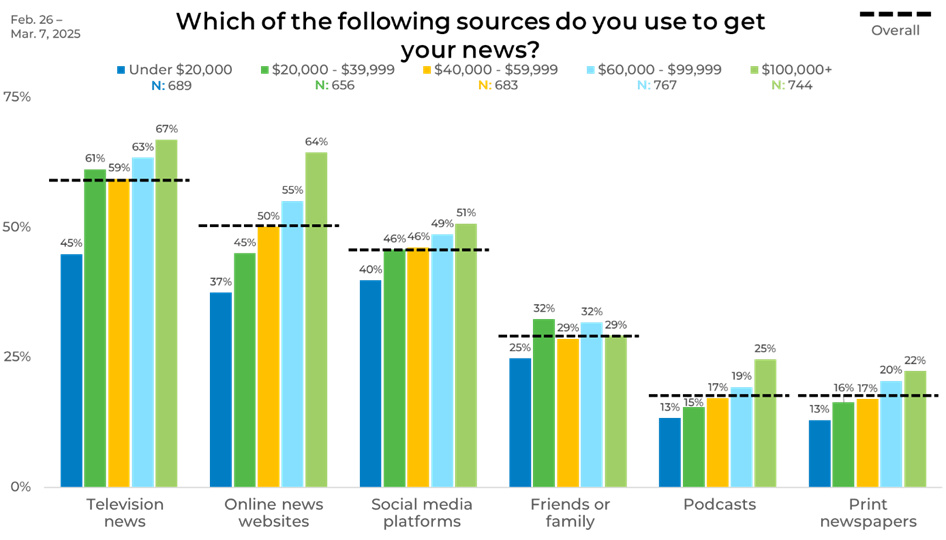
Ethnicity
When examining the data by ethnicity, there were distinct differences in preferred news sources. Caucasian respondents report the highest use of television news (62%) and online news (52%). African American respondents are more inclined toward social media (54%), while Asian or South Asian respondents favor online news websites (60%).
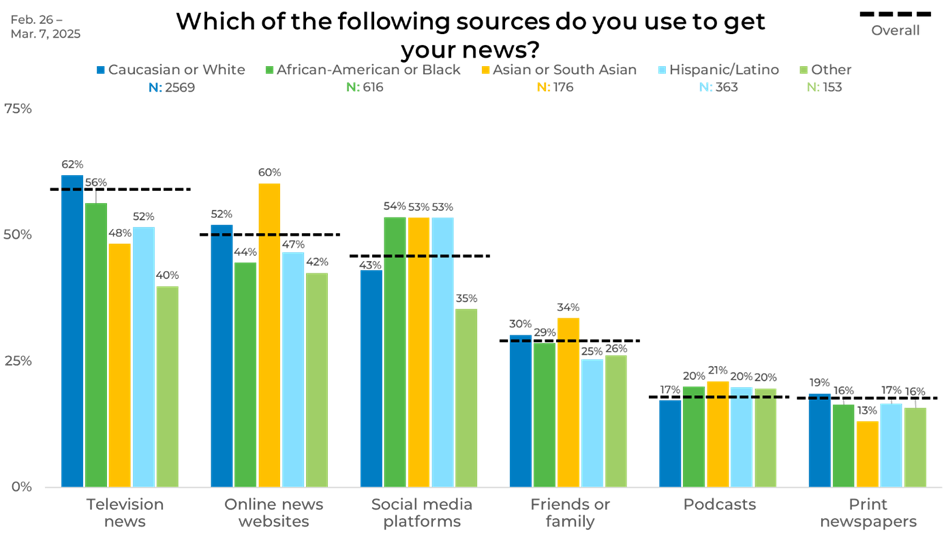
Panel
The media habits by panel source highlighted some interesting insights. Television news as a source had varying levels of usage depending on panel, ranging from 43% in Panel C to 63% in Panel H. Online news use shows even greater variation, spanning from 37% in Panel C to 67% in Panel N. Social media sees a smaller but notable difference, with a 9-point gap between Panel K and Panel N. Podcast and print newspaper use spike in Panels H and N, where podcast listening reaches 30%. Print usage reaches 27%, compared to just 16% to 18% elsewhere.
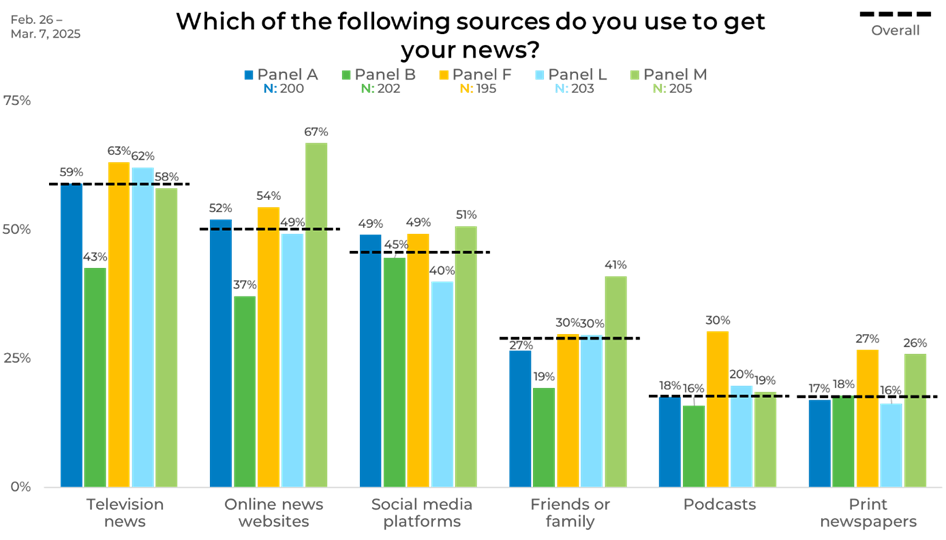
Trust in News Source
We now turn to people’s level of trust in different news sources, which is as divided as the platforms themselves. With so many ways to access information, public trust varies widely based on the source—some earning more credibility than others depending on format, demographics, and political alignment.
For clarity, respondents were asked to rate their trust on a scale from 1 (do not trust at all) to 5 (completely trust). We grouped the responses into top-two and bottom-two box responses.
Overall
At a high level, trust is strongest in local news stations, which lead all sources with 48% trust and only 19% distrust. National broadcast networks follow, with 43% of respondents trusting them and 26% distrusting them. In contrast, social media platforms and podcasts rank lowest in public trust, each trusted by just 25% and distrusted by 42% and 32%, respectively. Cable news and online news websites fall in the middle with mixed opinions—each drawing similar levels of trust and distrust.
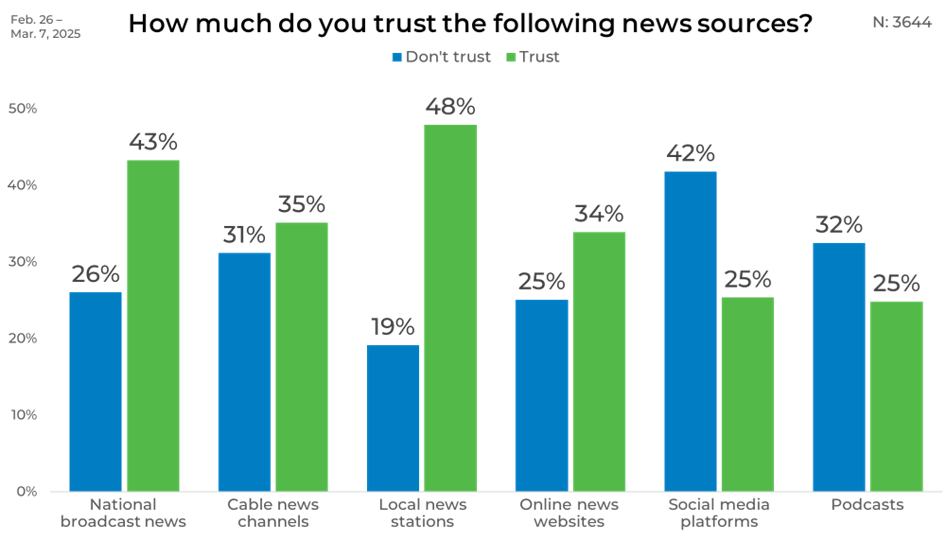
Age
Age has a huge impact on which news sources are trusted or distrusted. Older adults express the highest trust in local news (54%) and national broadcast networks (44%) but are also the most skeptical of social media (65% distrust) and podcasts (42% distrust). 18-to-24-year-olds trust social media (32%) and podcasts (27%) more than older groups, though their overall trust across all news sources is limited. Those aged 25 to 44 are most trusting of online news and podcasts, while middle-aged and older groups rely more on traditional outlets.
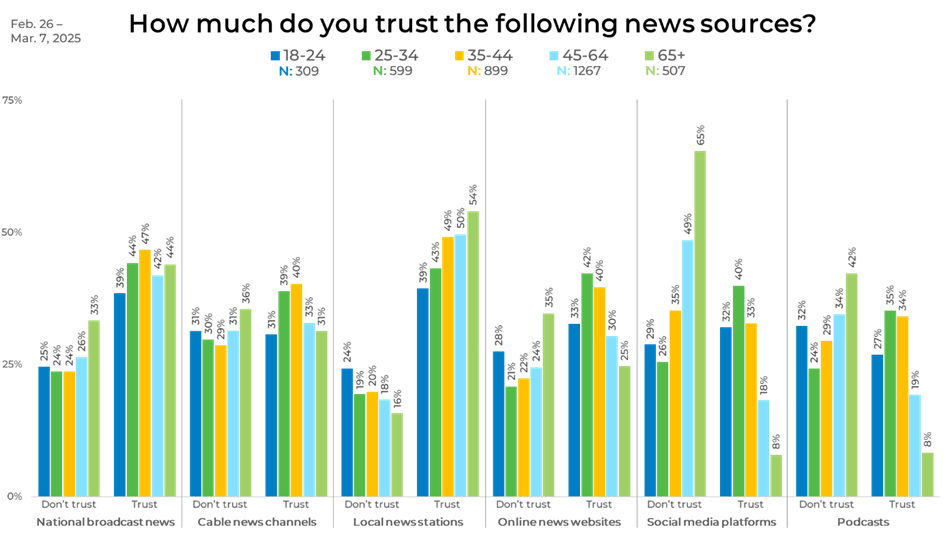
Income
Overall, trust in news sources tends to increase with income. Those earning $100,000 or more consistently report higher trust levels across nearly all formats, especially local news (56%) and national broadcast news (53%). By contrast, individuals earning under $20,000 express lower trust in these sources, at 42% and 39%, respectively. Cable news and online news trust also rise steadily with income, each reaching 46% in the highest bracket. Although trust in social media and podcasts remains comparatively low across all income levels, there is still a modest uptick among higher earners.
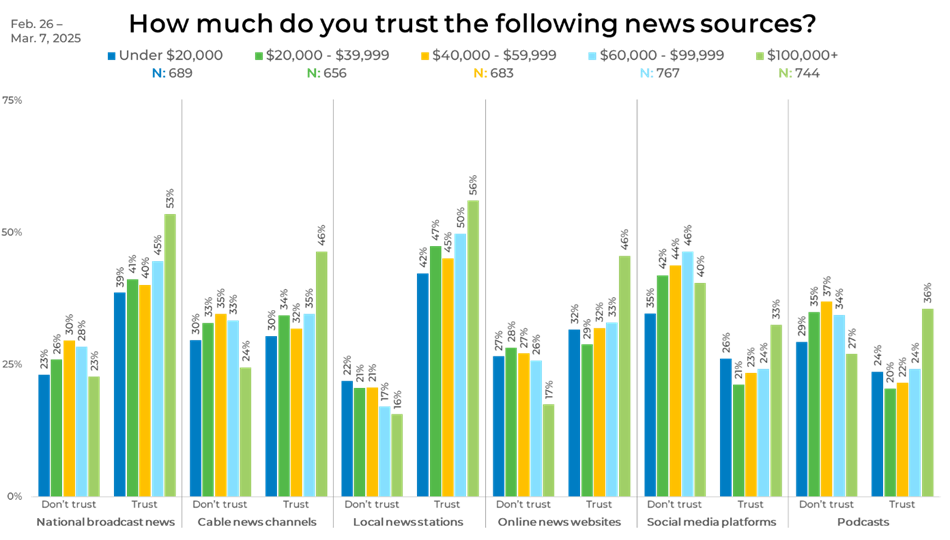
Political Affiliation
Political affiliation reveals more apparent distinctions in trust of news sources. Democrats express the highest trust in national broadcast news (58%) and local stations (58%), while Republicans are more skeptical, showing 34% distrust for national networks and 19% for local news. Independents fall in the middle, with 36% trusting national news and 41% trusting local news. Trust in cable news is fairly evenly divided between Republicans and Democrats (40% and 41%), although Independents report lower trust at 26%. Social media and podcasts are viewed with low trust across all groups, with slightly more optimism among Republicans toward podcasts (31%).
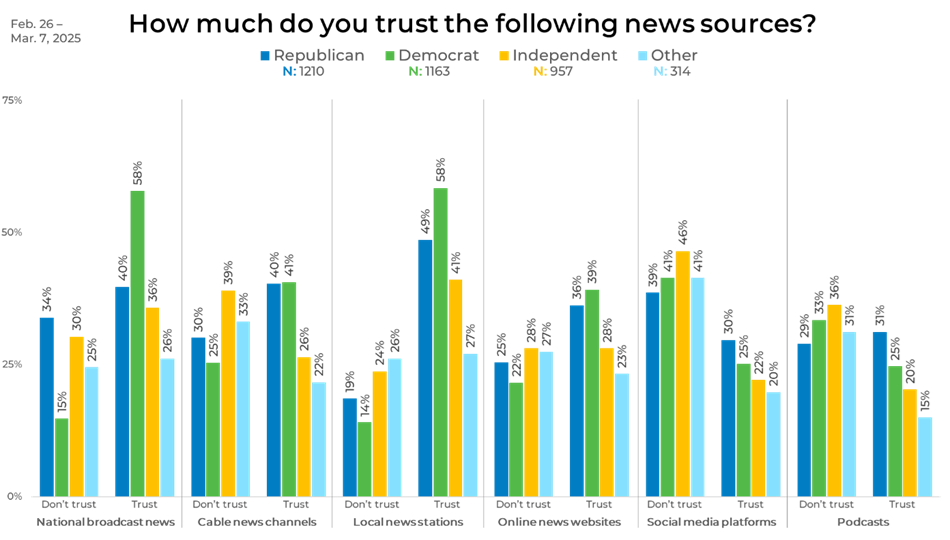
Ethnicity
Ethnic breakdowns show meaningful variation. African American respondents report higher trust in national broadcast news (49%) and social media (37%) compared to other groups. Caucasian respondents trust local news (48%) but are more skeptical of social media, with 21% trusting and 47% distrusting. Hispanic/Latino and Asian respondents report balanced trust in multiple formats, with stronger trust in online news (42% and 38%) and slightly higher confidence in podcasts compared to the average. Notably, distrust of social media spans all groups but is exceptionally high among Caucasians (47%) and Asian respondents (47%), while African American respondents report the lowest level of social media distrust at 26%. Trust across all ethnic groups remains highest for local news and lowest for social media.
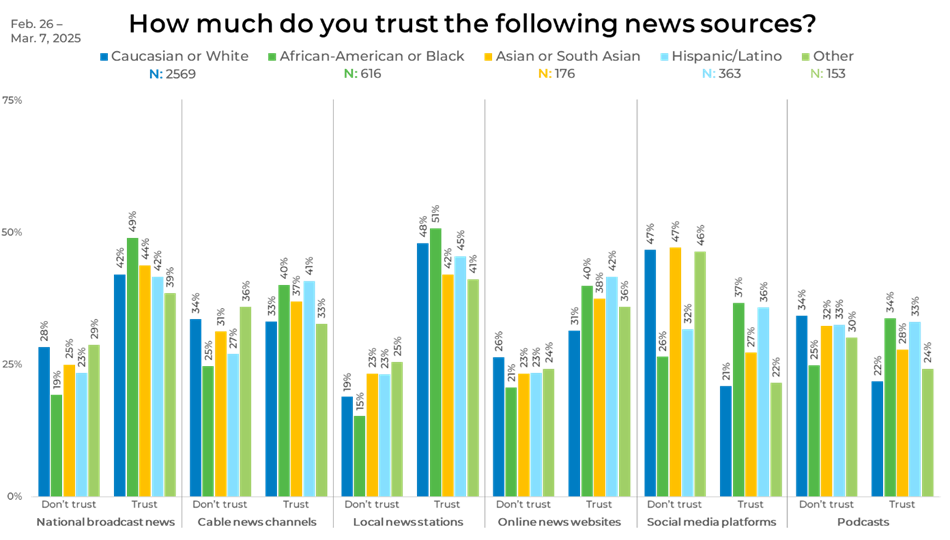
Panel
People’s trust in the various news sources varied significantly by panel source. For example, trust in national broadcast news varied from 37% in Panel A to 64% in Panel P. Trust in cable news fluctuated from 28% in Panel A to 57% in Panel P, while trust in online news ranged from 20% to 51% across the panels. Trust in social media reaches 41% in Panel P but falls to just 13% in Panel A. Podcast trust ranges from 15% to 41%. Notably, Panel P stands out with significantly higher trust across all sources, underscoring the considerable variation in results that can occur depending on the sample.
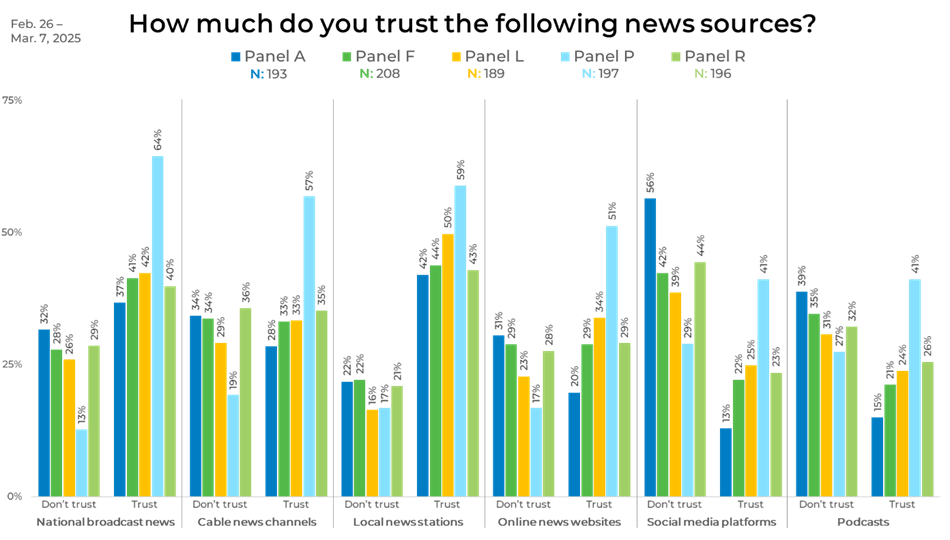
Panel makeup matters. That’s why we blend them—to cut bias and sharpen accuracy. Want to see how we do it? Check out our strategic sampling method below.





